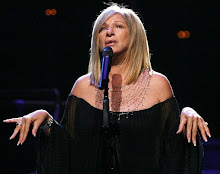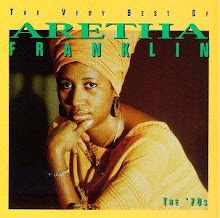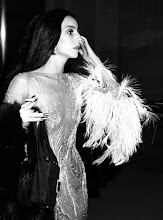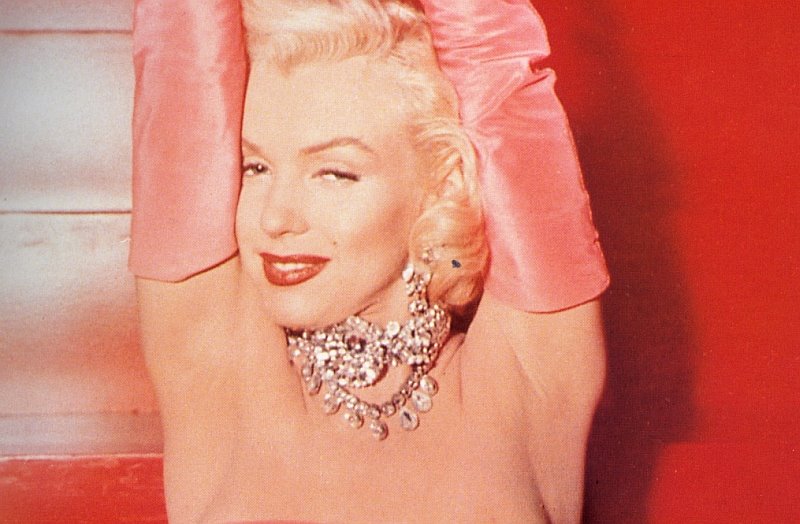By Susan G. Cole
Cyndi Lauper’s a little sick of being called a gay icon. I try it out on her and get a bit of a slapdown.
“Don’t call me that,” she says. “Sometimes the icon thing, it sounds frivolous. It’s not only about makeup.”
She thinks about that for a second and relents. “...although I love makeup. I am the Viva Glam girl. I actually regret that I have only one face for all this makeup.
“But I’m not Streisand, I’m not Liza Minnelli. I don’t even dance. I tried doing that once at the Gay Games in 1994, but the shoes alone made that hard.”
Reading her words doesn’t give you the full sense of what it’s like to chat with one of the world’s most enduring pop stars. Let’s just say that when she gets on a roll, it’s impossible to stop her. We’re eight minutes into what’s supposed to be a 15-minute interview before I try to sneak in another question.
“I just have to finish what I was just saying,” she says.
Then there’s that voice, and the squeaky, heavy-duty Queens accent that makes her sound like she’s five years old and not the veteran singer and actor with 10 albums behind her, a Grammy and an Emmy, too. So “Don’t call me that” comes across as “Dooo’nt coo-all me thee-at.”
Though she rejects icon status, she does allow that she’s super-connected to the queer community. Her story about that is, as she says, not frivolous at all.
“I thought of the gay community as a refuge to get away from, well, straight people, actually, who kept asking, ‘Why are you so different?’ and I couldn’t take it any more.”
When she was asked to sing at the Gay Games in 1994, she jumped at the chance. But she was upset at the way the organizers treated the drag queens.
“The drag performers weren’t celebrated, and nobody wanted to focus on them. They were never even on the Jumbotron,” she recalls. “And I got a little mad and thought to myself, ‘Okay, don’t show them. I’m gonna make a video. I’m gonna make these gays famous. And I’m not just gonna show their shoes – you’re going to get to know them.’”
After she made the video for Hey Now in Europe, her friends encouraged her to get her own float in New York’s Pride parade.
“A guy came up to me and handed me a rainbow flag and said, ‘Your song True Colors inspired me to design this flag,’” she recalls. “I’d written sang the song for my friend Gregory, who died of AIDS.”
Since then, she’s helped launch the True Colors tour, with proceeds going to gay rights groups, and the True Colors shelter for queer youth in New York City. She also recently launched the Give A Damn campaign to promote respect for queer people – that’s the TV spot in which Oscar winner Anna Paquin comes out as bisexual – and appeared on TV’s The Celebrity Apprentice, naming True Colors her charity.
Lauper says she’d been hearing about kids at risk for years.
“When you’re a teenager, the streets are hard – and it’s harder when you don’t have your family. People were writing me, and I kept hearing the same story about being thrown out, losing your friends, losing your job, being discarded. I’m a mother now, and I know I could never do anything like that, fucking never.
“You can’t work in a community and look at people and see something terribly wrong and not step in.”
When I jokingly express the wish – shared by many of her queer fans – that she switch sides and join the gay team, she is again not amused.
“We need straight people to step up and change things, because in our country gay people don’t have civil rights. This is a civil rights movement. We need the straight community to stand beside our gay sisters and brothers to make change. We need the power of the people – and that means all of the people.”
At the June 7 meeting at the 519 in support of free speech at Pride and to organize against Pride’s decision to ban the term “Israeli apartheid” at the big parade (Pride has since changed its mind about that), some activists suggested taking action at Lauper’s big concert Saturday (July 3) at Queen’s Park. Next to the Pride Day parade, her event is considered this year’s biggest draw. When I ask Lauper what she thinks about a protest at her gig, she gives it some serious thought.
“Oh,” she says, and I can almost hear the gears turning inside her head. “In a way it is like apartheid [in Israel], because the Palestinians are outside of the city like the South African blacks were.
“They [Queers Against Israeli Apartheid] should hand out information so people can read about it. For crying out loud, if people can hand out pamphlets for hamburgers or manicures, [QuAIA] should hand out theirs, as long as it’s backed up by information. If you have people’s stories, that’s the best.”
With all the political talk and Lauper’s high-profile support of the LGBT community, it’s easy to forget that she has a new album.
Memphis Blues (Downtown) features covers of blues classics, including Rollin And Tumblin’ and Wild Women Don’t Get The Blues. It could be seen as a major departure for one of the queens of pop, but Lauper says that isn’t so.
“This album is like coming home. I was trained by [jazz singer] Betty Scott. She was the one who taught me to listen to Billie Holiday. This is the basis of everything I’ve ever sung. Everything is based on blues and call-and-response – dance, rock, hip-hop.”
Lauper also got the benefit of some of the genre’s greatest session players.
“When Ann Peebles walked in to do guest vocals, I cried. I wanted to tell her how many times I sang with her in a hotel room, how many times I listened to I Can’t Stand The Rain.”
Lauper even got work from Skip Pitts, the man who played the wah-wah guitar hook on Isaac Hayes’s R&B classic Shaft.
“How many times have I been in a recording studio and said to the guitarist, ‘No, no, I want it like the guitar in Shaft’?” she asks me rhetorically. “Then I’m in the studio and I turn around and there he is – Skip Pitts.”
susanc@nowtoronto.com
NOW
June 30-July 7, 2010
VOL 29 NO 44
Go to Music
Thursday, July 1, 2010
Wednesday, June 30, 2010
SUSAN HAYWARD & LENA HORNE born on this day...
I was unique in that I was a kind of black that white people could accept. I was their daydream. I had the worst kind of acceptance because it was never for how great I was or what I contributed. It was because of the way I looked.
[quoted in Brian Lanker's book "I Dream A World: Portraits of Black Women Who Changed America", New York: Stewart, Tabori & Chang, 1986)] My own people didn't see me as a performer because they were busy trying to make a living and feed themselves. Until I got to café society in the '40s, I didn't even have a black audience and then it was mixed. I was always battling the system to try to get to be with my people. Finally, I wouldn't work for places that kept us out . . . it was a damn fight everywhere I was, every place I worked, in New York, in Hollywood, all over the world.
You have to be taught to be second class; you're not born that way.
It's not the load that breaks you down, it's the way you carry it.
Always be smarter than the people who hire you.
A little nepotism never hurt nobody, honey. If you got it, use it. Press on with it. Remind them of it.
In my early days I was a sepia Hedy Lamarr. Now I'm black and a woman, singing my own way.
On love: Don't be afraid to feel as angry or as loving as you can.
My identity is very clear to me now, I am a black woman, I'm not alone, I'm free. I say I'm free because I no longer have to be a credit, I don't have to be a symbol to anybody; I don't have to be a first to anybody. I don't have to be an imitation of a white woman that Hollywood sort of hoped I'd become. I'm me, and I'm like nobody else.
Susan Hayward in "I Want To Live" Best Actress Oscar Winner 1958.
Trivia
Was diagnosed with brain cancer, allegedly the result of being exposed to dangerous radioactive toxins on location in Utah while making The Conqueror (1956). All the leads John Wayne, Agnes Moorehead, John Hoyt, Hayward and the director Dick Powell died of cancer. The case is still a scandal.
Interred at Our Lady of Perpetual Help Catholic Church, Carrollton, Georgia, USA.
She portrayed an alcoholic in three films, Smash-Up: The Story of a Woman (1947), My Foolish Heart (1949) and I'll Cry Tomorrow (1955)) and was nominated for an Oscar for each performance.
Her footprints at Grauman's Chinese Theatre are the only ones set in gold dust.
Her first marriage to actor Jess Barker was a stormy one and ended with a bitter custody battle of her twin sons and a suicide attempt by Susan. Her second to rancher Eaton Chalkley was a long and happy one until he died suddenly of hepatitis nine years later. She left Hollywood for five years in deep mourning, returning in 1971.
Took over the ballsy role of stage star Helen Lawson in Valley of the Dolls (1967) in 1967 after Judy Garland was fired.
Was one of many starlets in 1939 who auditioned for the part of Scarlett O'Hara in Gone with the Wind (1939).
Measurements: 36 1/2-26-35 1/2 (as noted in "Hollywood Studio Magazine), (Source: Celebrity Sleuth magazine)
Replaced an ailing Barbara Stanwyck in Heat of Anger (1972) (TV), which was to have been a pilot for a TV series to be called "Fitzgerald and Pride."
In Italy, almost all of her films were dubbed by either Lidia Simoneschi or Rosetta Calavetta. She was occasionally dubbed by Dhia Cristiani.
Reportedly did not get on at all with Bette Davis during the filming of Where Love Has Gone (1964).
Was the original choice to play Margo Channing in All About Eve (1950), but was dropped from the project after being considered too young. The part was then given to Claudette Colbert before being given to Bette Davis, who went on to receive a Best Actress Oscar nomination for her performance.
Was born on the same day, and same place (Brooklyn N.Y) as singer Lena Horne .
Personal Quotes
"I learned at a very early age that life is a battle. My family was poor, my neighborhood was poor. The only way that I could get away from the awfulness of life, at that time, was at the movies. There I decided that my big aim was to make money. And it was there that I became a very determined woman."
"I never thought of myself as a movie star. I'm just a working girl. A working girl who worked her way to the top -- and never fell off."
"My life is fair game for anybody. I spent an unhappy penniless childhood in Brooklyn. I had to slug my way up in a town called Hollywood where people love to trample you to death. I don't relax because I don't know how. I don't want to know how. Life is too short to relax."
"When you're dead, you're dead. No one is going to remember me when I'm dead. Oh maybe a few friends will remember me affectionately. Being remembered isn't the most important thing anyhow. It's what you do when you are here that's important."
You aim at all the things you have been told that stardom means -- the rich life, the applause, the parties cluttered with celebrities. Then you find that you have it all. And it is nothing, really nothing. It is like a drug that lasts just a few hours, a sleeping pill. When it wears off, you have to live without its help.
Friday, June 25, 2010
Thursday, June 24, 2010
Tuesday, June 8, 2010
Thursday, June 3, 2010
RUE ~ "Queen of Comedy"
 "Golden Girls" star Rue McClanahan has died after a massive stroke. The actress passed away at 1:00 a.m. on June 3, her rep tells People. McClanahan, age 76, had previously suffered a minor stroke while recovering from bypass surgery earlier this year. Her rep notes that at the time of her death, McClanahan "had her family with her," saying, "She went in peace." Though McClanahan will best be remembered for her "Golden Girls" portrayal of Blanche Devereaux, she enjoyed a 50-year television career that included standout roles in "Maude," "The Love Boat," and most recently "Law & Order" and Tyler Perry's "Meet the Browns." Born in Healdton, Okla., McClanahan attended the University of Tulsa before moving to New York City where she worked as a file clerk before finding success in the theater. She was a life-long animal welfare advocate and vegetarian and supported PETA. McClanahan's death leaves Betty White as the only surviving regular cast member of "The Golden Girls," after Bea Arthur's death in 2009 and Estelle Getty's death in 2008. On a press call with Zap2it in late April, Betty spoke of her good friend and former cast mate. "Oh Ruesy. We talk about every, oh maybe three, four weeks. She lives in New York of course. And she had a bum go. She had a triple bypass and then had a stroke. And she's just doing fine. I talked with her. She's home and doing better and better and speech is all cleared up. She's in great shape. Isn't that good news?" McClanahan is survived by her sixth husband, Morrow Wilson, and her son Mark Bish. In her 2007 book "My First Five Husbands... and The One That Got Away," McClanahan wrote, "People always ask me if I'm like Blanche. And I say, 'Well, Blanche was an oversexed, self-involved, man-crazy, vain Southern Belle from Atlanta -- and I'm not from Atlanta.
"Golden Girls" star Rue McClanahan has died after a massive stroke. The actress passed away at 1:00 a.m. on June 3, her rep tells People. McClanahan, age 76, had previously suffered a minor stroke while recovering from bypass surgery earlier this year. Her rep notes that at the time of her death, McClanahan "had her family with her," saying, "She went in peace." Though McClanahan will best be remembered for her "Golden Girls" portrayal of Blanche Devereaux, she enjoyed a 50-year television career that included standout roles in "Maude," "The Love Boat," and most recently "Law & Order" and Tyler Perry's "Meet the Browns." Born in Healdton, Okla., McClanahan attended the University of Tulsa before moving to New York City where she worked as a file clerk before finding success in the theater. She was a life-long animal welfare advocate and vegetarian and supported PETA. McClanahan's death leaves Betty White as the only surviving regular cast member of "The Golden Girls," after Bea Arthur's death in 2009 and Estelle Getty's death in 2008. On a press call with Zap2it in late April, Betty spoke of her good friend and former cast mate. "Oh Ruesy. We talk about every, oh maybe three, four weeks. She lives in New York of course. And she had a bum go. She had a triple bypass and then had a stroke. And she's just doing fine. I talked with her. She's home and doing better and better and speech is all cleared up. She's in great shape. Isn't that good news?" McClanahan is survived by her sixth husband, Morrow Wilson, and her son Mark Bish. In her 2007 book "My First Five Husbands... and The One That Got Away," McClanahan wrote, "People always ask me if I'm like Blanche. And I say, 'Well, Blanche was an oversexed, self-involved, man-crazy, vain Southern Belle from Atlanta -- and I'm not from Atlanta.Wednesday, June 2, 2010
Secret Birthday Photo of John F. Kennedy and Marilyn Monroe Goes on Sale

by David Knowles
It's like a surprise party for gossip columnists and Camelotphiles: A rare photograph of Marilyn Monroe and President John F. Kennedy is up for sale. Just hours after Monroe sang her sultry rendition of "Happy Birthday" to then president Kennedy at Madison Square Garden, the film star attended a private party with the commander-in-chief where White House photographer Cecil Stoughton snapped the shot that has remained secret until now.
Taken at the home of Arthur and Matilda Krim on May 19, 1962, the photo also shows Kennedy's brother, Bobby, chatting with Monroe and the president. Harry Belafonte and his wife can also be seen. According to Kaya Morgan, the man selling the picture, Jackie Kennedy did not attend the party. "The photographer told me that when she heard Monroe would be there, [she] said 'screw this,' and left," Morgan told the Surge Desk.That the photo still exists may be the result of a Secret Service error. When Stoughton was developing his negatives from the famous party, the story goes, agents confiscated all those that showed Kennedy and Monroe together. But they missed one, Morgan said. The price for a previously secret piece of history? "A 30-inch signed original print will go for $23,000," said Morgan, who unveiled the photo on Tuesday in Los Angeles in part to commemorate Monroe's birthday.
Filed Under: Surge Desk
Tagged: Bobby Kennedy, Cecil Stroughton, Harry Belafonte, john f. kennedy, Kaya Morgan, Marilyn Monroe
Filed Under: Surge Desk
Tagged: Bobby Kennedy, Cecil Stroughton, Harry Belafonte, john f. kennedy, Kaya Morgan, Marilyn Monroe
Tuesday, May 25, 2010
Thursday, May 20, 2010
Tuesday, May 18, 2010
Melissa Etheridge: My Songs 'Aren't Gay Enough' for 'Glee'

By Nicki Gostin Posted May 17th 2010 01:34PM
Melissa Etheridge's eleventh studio album, 'Fearless Love,' is dropping at the same time as she's rebuilding her love life from the ground up. The 48-year-old songstress recently broke up with Tammy Lynn Michaels after nine years and having twins together in 2006. Etheridge spoke extremely candidly to PopEater about the painful timing of the split, the "sexphobia" behind the 'Glee'/Newsweek debacle and the absurdities of being called "too gay" or "not gay enough."Did you separate from Tammy before writing this album?It was written before we actually physically separated, but you know, breakups just don't happen overnight.It must suck having the album and the separation emerge at the same time. Do you wish the timing was different?[Laughs] Absolutely! When I saw these things were about to collide for a while there I thought, I don't want this to come up on top of the album, and then I started doing interviews and they're like, "You're such a family girl, your marriage is great, what's the key to a great marriage?" and I was like, "Oh, I can't sit here and lie." But I would have definitely made the timing different.So is the song 'Miss California' about Tammy?That's a political song. It's about California passing Proposition 8.
Have you been following the Newsweek controversy?No I haven't. Give me the scoop!A Newsweek writer said Sean Hayes was too gay to be in 'Promises Promises.' Kristin Chenoweth wrote a letter in his defense and Ryan Murphy from 'Glee' called for a boycott of the magazine.Oh, the gays are getting miffed! Don't tell us we're too gay or not or whatever. Oh lord, what is gay, anyway? Find me the line -- find me the defining line between gay and straight. Find me the defining line between male and female. There is no line. You cannot draw this line in the sand. Yes, there are plenty of people way over there who will never partake in anything straight and there are people way over there who will never partake in anything gay, but there's a whole lot of gray in the middle. Where's the line? Behind all of it is sexual insecurity. It's sexphobia.Have you been accused of not being gay enough?Oh sure. I've had the gay community say, "Why don't you write a song saying 'her'? Your lyrics are non-gender." They're never happy. And the straight folks, they just assume the lyrics are about a woman, and they assume that if they go to a concert it's going to be all gay people. There are stereotypes we all have. But there's no us and them. Good God, we're all the same.Have you ever been approached to have your songs on 'Glee?'No, I don't think they're gay enough. [Laughs]You're a greenie.Yup, no plastic bottles in my house. My car runs on bio-diesel, which is reclaimed vegetable oil from restaurants.Do you compost?I did for a while, but I was horrible at it. I had rats.I reckon someone could start a business in LA tending compost heaps.I can see it! Compost-For-You. Let's do it! I'll invest.Do you like touring?Touring is the payoff after all the days of being alone in my room writing these songs. I get to see people singing them. It's wonderful.You must have tons of groupies.Well, this will be the first time I'm touring and I'm single. But I am not interested in groupies. I don't need that in my life right now. I have my oldest kids with me on tour -- they're 13 and 11.How do you embarrass them?It's funny because they've drawn a line between what I do for a living, getting up there and singing for people. They allow that because they know that's my work, but if I'm standing around at school and I hum or sing something, they're like, "Oh mom, don't!"I think you are quite the sex symbol.Aww, you're sweet, and you're helping this gal. Thank you so much.Aren't you best pals with Brad Pitt?Not for a while. He's a family man. I haven't spoken to him in a while.How's your health?My health is great. I've been six years free of cancer. I figured out health is about balance. It's what you eat, what you feel, how much you sleep. It's really common things that western society doesn't teach us how to do. You've got to take responsibility; you've got to say, "You know what? I don't need to work that hard. I don't have to buy this." It's not what it's all about.
WATCH MELISSA'S "Fearless Love" video.
Mariah Carey Puts Out Stage Fire Herself
By PopEater Staff Posted May 18th 2010 06:45AM
Mariah Carey acted quickly to put out a fire on stage before her recent concert in Egypt.
The singer used her Twitter to describe the situation. "In Egypt getting ready to go on stage and suddenly there was a surge of power and an electrical fire started under my feet! Wtf?!"
"Naturally, my emergency instincts kicked in and I put out the flames w/a towel. Lol (yet true)," she added.
She finished, "The funny thing about this ish [sic] is an ol'skool radio station in the other room started playing 'aww freak out!' @that exact moment!"
Carey even tweeted a photo of "the charred remains."
Mariah Carey acted quickly to put out a fire on stage before her recent concert in Egypt.
The singer used her Twitter to describe the situation. "In Egypt getting ready to go on stage and suddenly there was a surge of power and an electrical fire started under my feet! Wtf?!"
"Naturally, my emergency instincts kicked in and I put out the flames w/a towel. Lol (yet true)," she added.
She finished, "The funny thing about this ish [sic] is an ol'skool radio station in the other room started playing 'aww freak out!' @that exact moment!"
Carey even tweeted a photo of "the charred remains."
Monday, May 17, 2010
Raquel Welch, Reluctant Sex Symbol
This summary is not available. Please
click here to view the post.
Monday, May 10, 2010
Legendary Singer Lena Horne Dies at 92
Verena Dobnik AP 

NEW YORK (May 9) - Lena Horne, the enchanting jazz singer and actress who reviled the bigotry that allowed her to entertain white audiences but not socialize with them, slowing her rise to Broadway superstardom, died Sunday. She was 92.Horne died at NewYork-Presbyterian Hospital, according to hospital spokeswoman Gloria Chin. Chin would not release any other details.Horne, whose striking beauty and magnetic sex appeal often overshadowed her sultry voice, was remarkably candid about the underlying reason for her success.
"I was unique in that I was a kind of black that white people could accept," she once said. "I was their daydream. I had the worst kind of acceptance because it was never for how great I was or what I contributed. It was because of the way I looked."In the 1940s, she was one of the first black performers hired to sing with a major white band, the first to play the Copacabana nightclub and among a handful with a Hollywood contract.In 1943, MGM Studios loaned her to 20th Century-Fox to play the role of Selina Rogers in the all-black movie musical "Stormy Weather." Her rendition of the title song became a major hit and her signature piece.On screen, on records and in nightclubs and concert halls, Horne was at home vocally with a wide musical range, from blues and jazz to the sophistication of Rodgers and Hart in songs like "The Lady Is a Tramp" and "Bewitched, Bothered and Bewildered."In her first big Broadway success, as the star of "Jamaica" in 1957, reviewer Richard Watts Jr. called her "one of the incomparable performers of our time." Songwriter Buddy de Sylva dubbed her "the best female singer of songs."But Horne was perpetually frustrated with the public humiliation of racism."I was always battling the system to try to get to be with my people. Finally, I wouldn't work for places that kept us out ... it was a damn fight everywhere I was, every place I worked, in New York, in Hollywood, all over the world," she said in Brian Lanker's book "I Dream a World: Portraits of Black Women Who Changed America."While at MGM, she starred in the all-black "Cabin in the Sky," in 1943, but in most of her other movies, she appeared only in musical numbers that could be cut in the racially insensitive South without affecting the story. These included "I Dood It," a Red Skelton comedy, "Thousands Cheer" and "Swing Fever," all in 1943; "Broadway Rhythm" in 1944; and "Ziegfeld Follies" in 1946."Metro's cowardice deprived the musical of one of the great singing actresses," film historian John Kobal wrote.Early in her career Horne cultivated an aloof style out of self-preservation, becoming "a woman the audience can't reach and therefore can't hurt" she once said.Later she embraced activism, breaking loose as a voice for civil rights and as an artist. In the last decades of her life, she rode a new wave of popularity as a revered icon of American popular music.Her 1981 one-woman Broadway show, "Lena Horne: The Lady and Her Music," won a special Tony Award. In it, the 64-year-old singer used two renditions - one straight and the other gut-wrenching - of "Stormy Weather" to give audiences a glimpse of the spiritual odyssey of her five-decade career.A sometimes savage critic, John Simon, wrote that she was "ageless. ... tempered like steel, baked like clay, annealed like glass; life has chiseled, burnished, refined her."When Halle Berry became the first black woman to win the best actress Oscar in 2002, she sobbed: "This moment is for Dorothy Dandridge, Lena Horne, Diahann Carroll. ... It's for every nameless, faceless woman of color who now has a chance because this door tonight has been opened."Lena Mary Calhoun Horne, the great-granddaughter of a freed slave, was born in Brooklyn June 30, 1917, to a leading family in the black bourgeoisie. Her daughter, Gail Lumet Buckley, wrote in her 1986 book "The Hornes: An American Family" that among their relatives was a college girlfriend of W.E.B. Du Bois and a black adviser to Franklin D. Roosevelt.Dropping out of school at 16 to support her ailing mother, Horne joined the chorus line at the Cotton Club, the fabled Harlem night spot where the entertainers were black and the clientele white.She left the club in 1935 to tour with Noble Sissle's orchestra, billed as Helena Horne, the name she continued using when she joined Charlie Barnet's white orchestra in 1940.A movie offer from MGM came when she headlined a show at the Little Troc nightclub with the Katherine Dunham dancers in 1942.Her success led some blacks to accuse Horne of trying to "pass" in a white world with her light complexion. Max Factor even developed an "Egyptian" makeup shade especially for the budding actress while she was at MGM.But in his book "Gotta Sing Gotta Dance: A Pictorial History of Film Musicals," Kobal wrote that she refused to go along with the studio's efforts to portray her as an exotic Latin American."I don't have to be an imitation of a white woman that Hollywood sort of hoped I'd become," Horne once said. "I'm me, and I'm like nobody else."Horne was only 2 when her grandmother, a prominent member of the Urban League and the National Association for the Advancement of Colored People, enrolled her in the NAACP. But she avoided activism until 1945 when she was entertaining at an Army base and saw German prisoners of war sitting up front while black American soldiers were consigned to the rear.That pivotal moment channeled her anger into something useful.She got involved in various social and political organizations and - along with her friendship with Paul Robeson - got her name onto blacklists during the red-hunting McCarthy era.By the 1960s, Horne was one of the most visible celebrities in the civil rights movement, once throwing a lamp at a customer who made a racial slur in a Beverly Hills restaurant and in 1963 joining 250,000 others in the March on Washington when Martin Luther King Jr. gave his "I Have a Dream" speech. Horne also spoke at a rally that same year with another civil rights leader, Medgar Evers, just days before his assassination.It was also in the mid-'60s that she put out an autobiography, "Lena," with author Richard Schickel.The next decade brought her first to a low point, then to a fresh burst of artistry.She had married MGM music director Lennie Hayton, a white man, in Paris in 1947 after her first overseas engagements in France and England. An earlier marriage to Louis J. Jones had ended in divorce in 1944 after producing daughter Gail and a son, Teddy.In the 2009 biography "Stormy Weather," author James Gavin recounts that when Horne was asked by a lover why she'd married a white man, she replied: "To get even with him."Her father, her son and her husband, Hayton, all died in 1970-71, and the grief-stricken singer secluded herself, refusing to perform or even see anyone but her closest friends. One of them, comedian Alan King, took months persuading her to return to the stage, with results that surprised her."I looked out and saw a family of brothers and sisters," she said. "It was a long time, but when it came I truly began to live."And she discovered that time had mellowed her bitterness."I wouldn't trade my life for anything," she said, "because being black made me understand."
Filed under: Nation, Entertainment
Filed under: Nation, Entertainment
Tuesday, May 4, 2010
Monday, May 3, 2010
Subscribe to:
Comments (Atom)
























































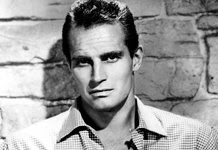

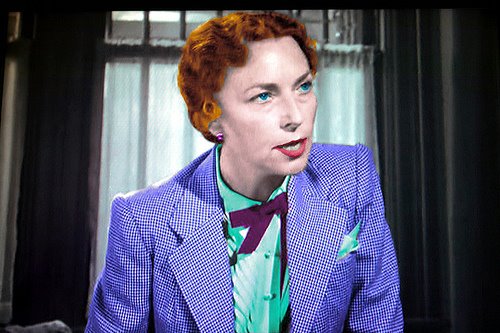



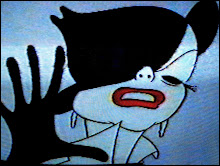.jpg)











